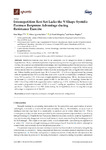Interrepetition rest set lacks the v-shape systolic pressure response advantage during resistance exercise

View/
Use this link to cite
http://hdl.handle.net/2183/20004
Except where otherwise noted, this item's license is described as Creative Commons Attribution (CC BY)
Collections
- Investigación (CCDEF) [297]
Metadata
Show full item recordTitle
Interrepetition rest set lacks the v-shape systolic pressure response advantage during resistance exerciseDate
2017Citation
Mayo, X.; Iglesias-Soler, E.; Kingsley, J.D.; Dopico, X. Interrepetition rest set lacks the v-shape systolic pressure response advantage during resistance exercise. Sports. 2017, 5, 90
Abstract
[Abstract] Resistance exercise may lead to an aneurysm due to dangerous levels of systemic hypertension. Thus, a minimized pressure response during exercise may guarantee safer training. For that, we analyzed an interrepetition rest design (IRD) hypothesizing that it would produce a lower systolic blood pressure (SBP) response in comparison with a continuous design (CD). Additionally, we studied the effect of accumulated repetitions on the increasing SBP rate during the first continuous set. Fifteen healthy participants (age: 24 ± 2 years; SBP: 113 ± 8 mmHg) performed leg presses, with 40 repetitions and 720 s of total rest, structured in an IRD of individual repetitions (resting time: 18.5 s), and in a CD of five sets of eight repetitions (resting time: 180 s). Analyses reported an increase (p = 0.013) in the mean peaks of SBP in the IRD (162 ± 21 mmHg), versus the CD (148 ± 19 mmHg), while both augmented versus baselines (p < 0.001). Additionally, the linear model estimated a progressive increase of SBP of around 7 mmHg per repetition. Summarily, the IRD produced a higher mean of the SBP peaks during the 40 repetitions due to lacking the v-shape advantage in comparison with the CD.
Keywords
Pressure response
Aneurysm
Strength exercise
Set configuration
Aneurysm
Strength exercise
Set configuration
Editor version
Rights
Creative Commons Attribution (CC BY)
ISSN
2075-4663






